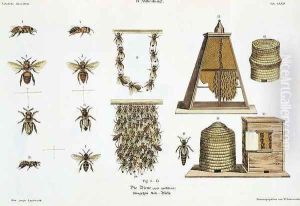Matthias Trentsensky Paintings
Matthias Trentsensky was an Austrian artist, lithographer, and illustrator, born on September 28, 1790, in Brno, Moravia, which at the time was part of the Habsburg Empire and is now in the Czech Republic. He is especially noted for his contributions to the field of lithography, a printmaking technique that was relatively new at the time and allowed for the mass production of images.
Trentsensky moved to Vienna, which was a significant cultural and artistic hub in Europe during the early 19th century. There, he became involved with the artistic circles and started to explore lithography, which was invented at the end of the 18th century by Alois Senefelder. Trentsensky quickly recognized the potential of this medium for reproducing art, as well as for creating illustrations for books, sheet music, and other publications.
In 1819, Trentsensky founded his own publishing company in Vienna, which specialized in lithographic prints. His firm became one of the most important of its kind in the city, producing a wide range of graphic works that included educational charts, portraits, caricatures, and scenes of everyday life. Trentsensky's work often reflected the Biedermeier period, characterized by a focus on the domestic and the unpretentious, which was prevalent in the German-speaking world at the time.
As an illustrator, Trentsensky also contributed to children’s literature, creating images for fairy tales, instructional books, and games, which were becoming increasingly popular. His illustrations were known for their fine detail, lively character, and often humorous content, which made them appealing to both children and adults.
Throughout his career, Trentsensky collaborated with other artists and intellectuals of his time, contributing to the vibrant cultural scene of Vienna. His works were widely distributed and enjoyed by a broad audience, thanks in part to the accessibility and affordability of lithographic prints compared to other forms of art reproduction.
Matthias Trentsensky passed away on May 8, 1868, in Vienna. Although not as well known today as some of his contemporaries, his contributions to the field of lithography and illustration during the 19th century were significant. His legacy is preserved in the collections of various museums and libraries, which hold examples of his lithographs and illustrated books, documenting an important chapter in the history of printmaking and visual culture.




